
Bo Atkinson 2021
This adventure begins with backyard science and later moves into geometric precision offered by personal computers. A comment area also welcomes questions at any level, at Field Structure Institute.
The typical magnetic field can be geometrically altered or differently structured by specially shaping coil windings and/or cores. This enjoyable idea explored many relatable forms in succession, over many years, and succeeding webpages were posted on harmoniouspalette, but this work was insufficiently correlated. This webpage begins to discuss the interrelationships of multi-axis helices, which begins with biaxially coiled wires.

The term poloidal was found later and adopted because it suggested swirling force field phenomena. Decades later in 2021, a new attempt is made to summarize and illustrate the work.
Gradual book-study and physical modeling of relatable geometry, preceded personal computer access to modeling apps and the internet, all of which developed this work gradually.
Orthogonal alignments are here considered as the baseline axis, notwithstanding the unfinished optimization of poloidal attributes. A toroidal outline illustrated below, emphasizes the objective of crossing axial inputs which can produce a third structural field form.
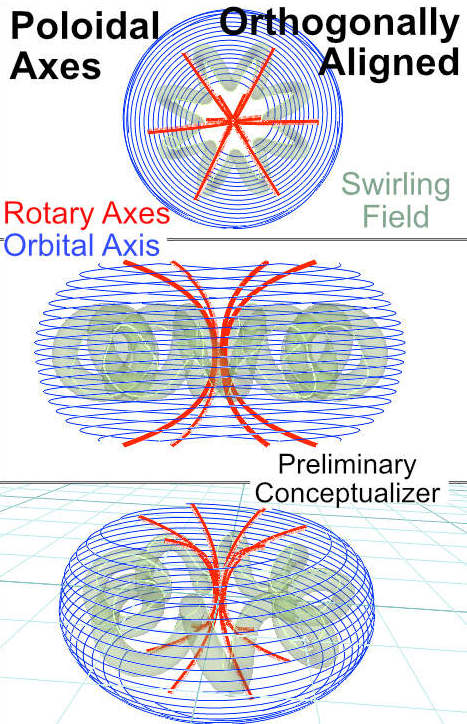
Before the word poloidal was found, the term Biaxial Windings seemed appropriate, because there were primarily two axes visualized on the surfaces to receive copper wire windings.
What "found item" could serve as a pre- formed core, with which to wind a biaxial coil? A junked part was found for winding which possessed a wider frequency response than steel.
Re- purposing a rare cylindrical ferrite core from a cathode ray tube, (from an old TV set), quickly provided two easily aligned crossways-surfaces, which formed two nearly orthogonally winding axes, on one core.
Image Below: The windings are crude, but adequate for preliminary experimentation.
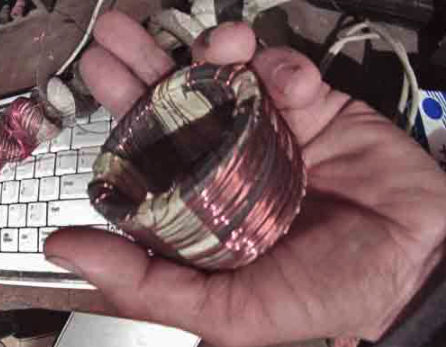
The original goal and purpose was to shape and observe coil effects, and then to rebound further thoughts for coil shaping experimentation.
Fractal coiling of pre-wound electromagnetic coils upon pre-wound electromagnetic coils, was the aim, repeated as far as possible, which soon
becomes physically impractical, but conducive for further thought.
A succession of form modeling explored possible methods to increase the number of windings expediently. Could more intricate patterns of multiaxial or fractal arrangements produce interesting effects? This was a general interest, where preliminary art forms tested visualizations. The materials and test equipment were elementary. Available materials limited the available range of frequency and the strength of current, and therefore, also, other possible effects. Experimenters are encouraged consider these possibilities.
Multi- axis coil rewinding.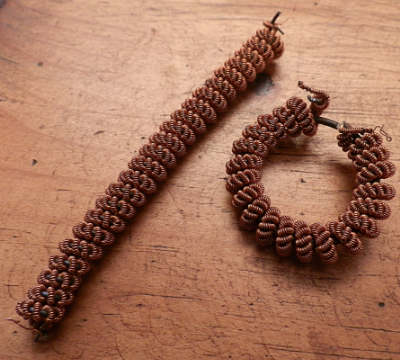
A curious biaxial precedent was later found in a physical library, (published long before personal computers), which somehow associated the term 'poloidal', for two orthogonal axes in one integral core, and of two or more intermixing axes. A hard bound book Magneto Hydrodynamics described something similar, about astrophysical phenomena and as a specialized word usage, (and this book did not show up in google search at this writing). The term poloid was affectionately adopted for biaxial helices, except that the obscure astrophysical terms are not common. Next is page 128 from the book.
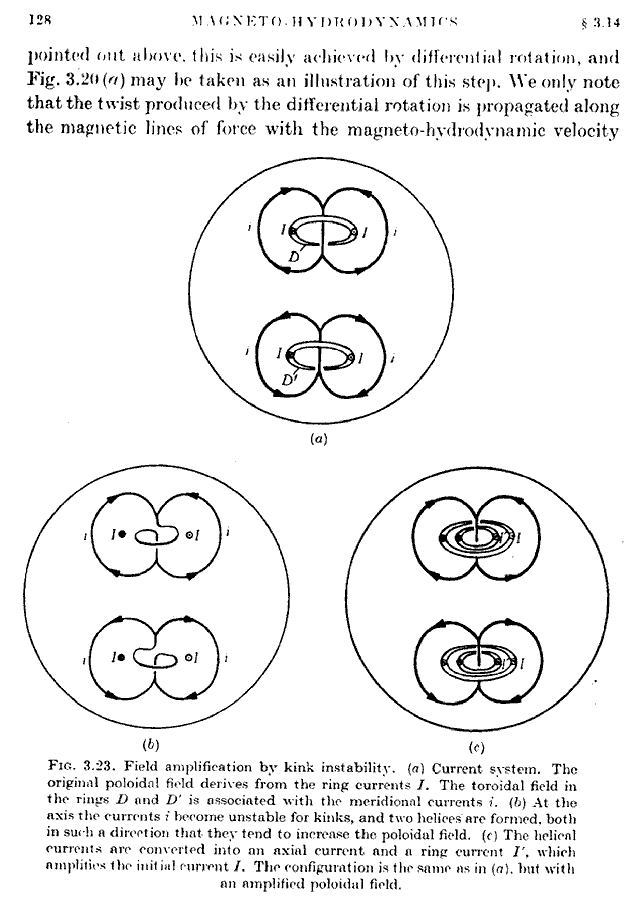
The photo-copied page in the image above might possibly be the earliest, original, published, and graphical example of this kind of orthogonal polarization. Hitherto unknown effect may yet be found with the right sort of toroidal-poloidal- spherical apparatus with appropriate electronic signals and power levels.
Quote from Caption part (b) "At the axis the currents i become unstable for kinks, and two helices are formed, both in such a direction that they tend to increase the poloidal field." This explanation may or may not have meant that both fields merge into one field, but the part (b) graphic does appear that way, and googling the word "poloidal", today, shows that atomic reactors are currently using the word poloidal, illustrated by a swirling flow.
Next is an enlargement of the poloidal characterization in part (b).
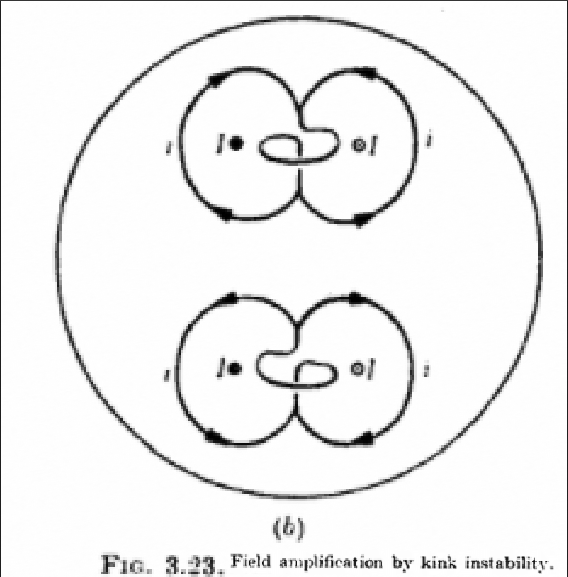
The orthogonal interaction within one field is suggested to impart a swirl along the path with a dominant direction or pattern. Poloidal fields could hypothetically include artificially balanced biaxial windings, whose windings interpose two orthogonally directed paths, within one radiated field, which significantly differs from conventional electronic coils. The resulting field might be studied to ascertain a swirling field pattern and attain efficiencies.
Years later some published photographic evidence seemed to display poloidal evidence in galaxies, or stages of galactic evolution. This encouraged the simpler work at hand, because biaxial alignments are recognized in nature.
Page 233 of The book "The Big Bang Never Happened", (by Eric Lerner), simulates characteristic galactic outlines, below.
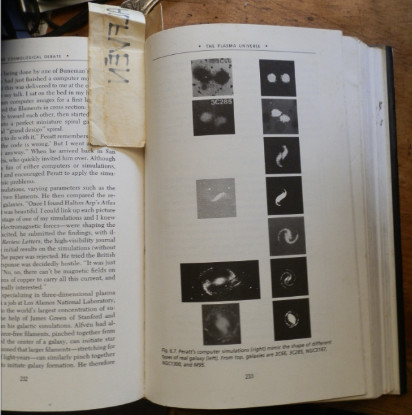
Tiny snapshots above, seemed to suggest positional orientations of top and side views geometrically, as these may be structural identifiers.
Independently reasoned here: The low resolution outlines might suggest a toroidal or poloidal structure of energy fields.
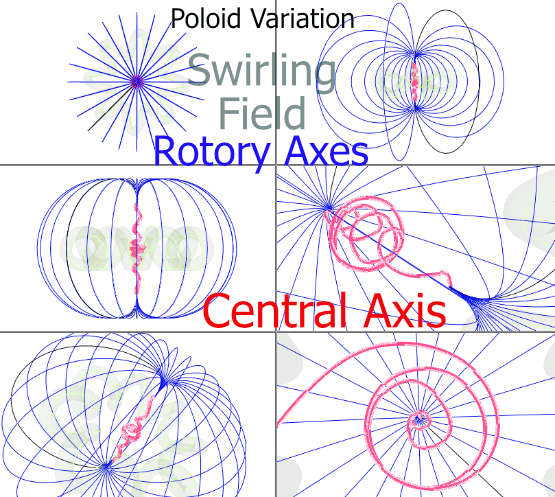
Poloidal fields could hypothetically include variations of biaxial windings, referring to toroidal twisted windings which are serially connected as one electrical conductor. Above: The (latitudinal), red windings are considered all bunched together in this variation, and induce a transverse field to the (longitudinal), blue windings, yielding the predicted swirling field (colored pale green). Powerful manipulation of 3d CAD tools generates varieties of forms, enabling a significant time- savings, to better explore new grounds of form.
Next Below: The familiar toroidal coil, on the left side of image, was manipulated in 3d CAD. The result is expected to induce a swirling magnetic field, however direct current and alternating current fields will introduce an exhaustive list of hypothetical scenarios.
The 3d CAD modeling of this became possible around 2001 with the commercial app formZ, (although modeling tools were much less manipulatable in that year, as compared with subsequent upgrades of softwares).
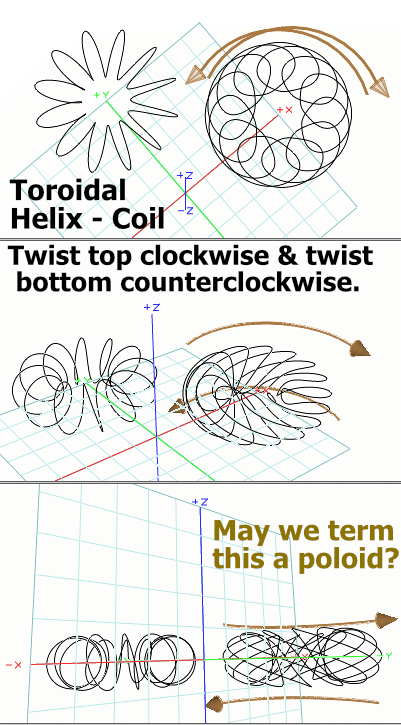
Above: A few clicks with an adequate 3d app easily twists the regular toroid as much as the user desires by simply typing the number of degrees.
However, with more work, the central wires may be closely aligned to the vertical form, as is found in the toroidal helix, and yet a biaxial or special poloid is obtained, which has reasonably longitudinal windings along the donut hole and reasonably latitudinal or orbital windings along the outside of the torus form.
The above exercise of twisting the top and the bottom of a toroid, is physically possible with copper wound coils, “on the kitchen table”, however the means of proving the resulting variously modeled magnetic fields would need sophisticated setups; and furthermore the longer list of modeling scenarios suggests a much more concerted effort.
The next image below attempts to show a range versatility, with twisting toroids.
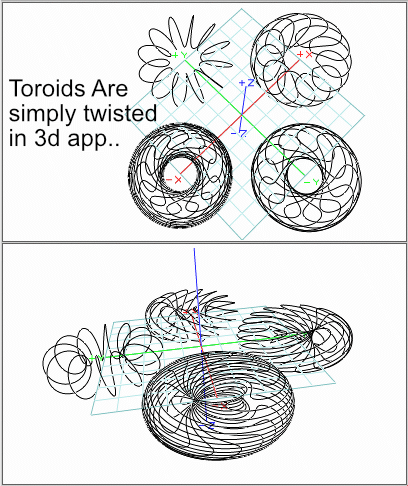
Preliminary 3d models can predict the lengths of wire which do lengthen for the outermost windings, and which complicate the physical twisting operation, and may demand restarting anew, to say nothing of selecting the finished material properties, respective to the purpose(s) of the given coil model. (Plan ahead).
In 1980, a non-profit endeavor named enersearch was tried, in anticipation a of life spent modeling and long before many of these ideas took a detailed form. The corporate aspect was a naive thrust which at least provided some pressure needed to do boring work, while developing ideas could bounce around in the mental plane.
The corporation was later abandoned for lack of it's public appeal. Today the the fuller fledged "open source" aspect remains, simply as a commitment to serve live, by sharing knowledge.
When 3D CAD apps became affordable, exploration of multi- axial forms expanded in various directions. The term nexinductor came to mind as the virtual modeling was not restricted by lack of materials or budgets.
A modeling content of symmetry has been my objective in these models and finding symmetries is very time consuming and somewhat uncertain of significant success. Following up on virtual modeling, a preliminary physical model clarifies more details unseen before, by providing the sensory observations and experiences of it's energizing effects, and life needs an energizer beyond food. The suddenly arriving 3D CAD tools extended the sensory faculty by pre- testing geometry with accurate visual tools, and offering detailed explorations of structural relationships, clearly speeds up modeling for the human world.
The animation below attempts to show how the torus formula eventuates a spherical form by scaling the minor radius. Is a toroid really just a specially scaled sphere? Perhaps not by ordinary conventions; however, a toroid coil may take that form, as shown by editing a torus coil with 3D CAD. At the end of the animation, the spherical convergence is developing, easily reaching a spherical resolution.
Note the Inspector box where the Radius value is successively changed, by manual typing. Focus on the editing box where the minor radius value is edited, which results in a transformation from toroidal to spherical forms.
The gif animation is here on :
At extremely high scaling of the minor radius, a convergence is reached near enough to "round off the numerical values" for a moderate display and thereby satisfactorily intersect all crossing arcs or lines, for even numbers of turns in a toroid, and this helix represent yet another wire sphere.
A caveat for electrical wires is the overlap of woven wires which cross at the poles. Tools to physically build or wind this geometry would need customized manufacturing. An adequate 3d printer could print a well-formed geometry file, to observed refined poloidal windings. To complicate such propositions, the further exploration of winding upon windings of windings quickly becomes very much more complex, (with conductors and insulators included in the print). Yet industry promises to 3d print any properly formatted 3d file that you send them!

My own, preliminary, hand made models were electrically powered by electrical frequency generators, and observations of waveforms were made on an oscilloscope, which prepared me for 3d modeling of poloidal axes.
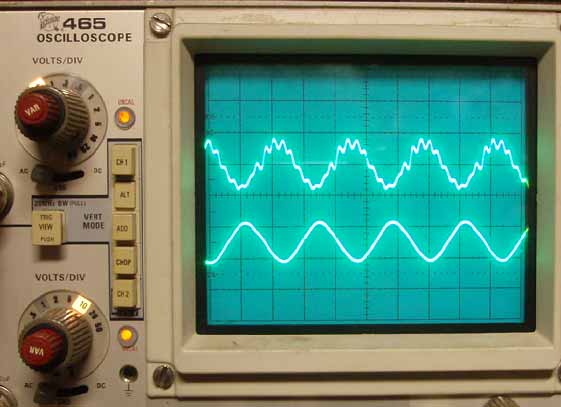
This kind of oscilloscope display was found in only several multi- axial coil outputs, (and perhaps only one was so pronounced), where harmonics are derived, from plain sine wave inputs; and therefore, are considered as a possible, developable effect for frequency multiplication, through the development of more finely rendered poloidal coil models and core materials.
For inductively coupled coils, where the primary turns regularly arc between one axis and another, a swirling magnetic current may result; and a nearly-planar, coupled-secondary winding detects weak harmonic modulations which may suggest inductive means for frequency multiplication. This work fell off as new inspirations and life itself demanded other tasks be done.
I welcome questions at any level and/or comments at Field Structure Institute.